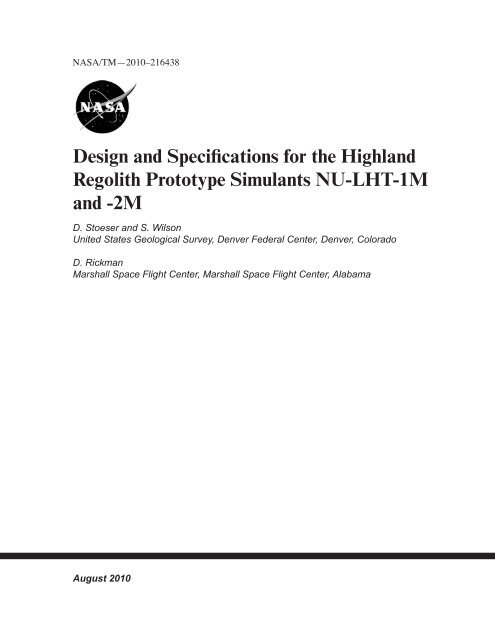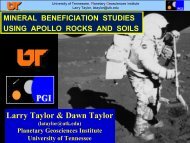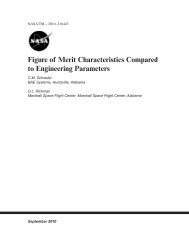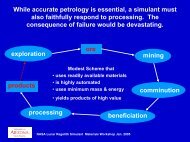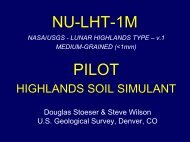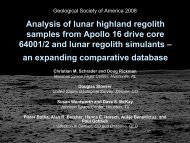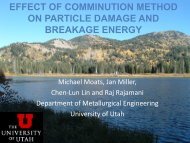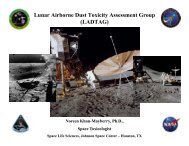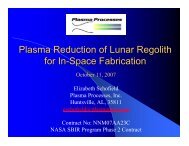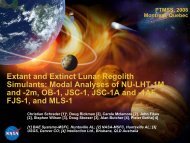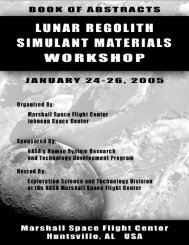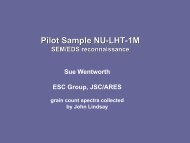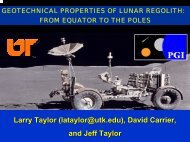Design and Specifications for the Highland Regolith Prototype - NASA
Design and Specifications for the Highland Regolith Prototype - NASA
Design and Specifications for the Highland Regolith Prototype - NASA
- No tags were found...
Create successful ePaper yourself
Turn your PDF publications into a flip-book with our unique Google optimized e-Paper software.
Available from:<strong>NASA</strong> Center <strong>for</strong> AeroSpace In<strong>for</strong>mation7115 St<strong>and</strong>ard DriveHanover, MD 21076 –1320443 –757– 5802This report is also available in electronic <strong>for</strong>m atii
TABLE OF CONTENTS1. INTRODUCTION ............................................................................................................... 12. CHEMICAL COMPOSITION SPECIFICATION ............................................................. 23. SPECIFICATIONS FOR LUNAR HIGHLANDS TYPE COMPONENTS ...................... 33.1 Crystalline Component .................................................................................................. 33.2 Glass Component ........................................................................................................... 54. MIXING SPECIFICATION ............................................................................................... 75. PARTICLE SIZE SPECIFICATION ................................................................................... 8APPENDIX .............................................................................................................................. 9iii
LIST OF FIGURES1. Cumulative grain size distribution <strong>for</strong> six Apollo 16 regolith samples ........................... 82. Figure 2 of Carrier (1973) showing regolith grain size distribution envelopebased on Carrier’s compilation of grain size in<strong>for</strong>mation <strong>for</strong> Apollo 11–15regolith samples ............................................................................................................ 8iv
LIST OF TABLES1. Average Apollo 16 “soil” composition from table 7 ...................................................... 32. Calculated normative mineral content based on <strong>the</strong> <strong>NASA</strong> (1982) averagefrom table 1 (using IGPET 2005 <strong>and</strong> CIPW norm programs by Michael Carr,Terra Softa Inc ® ) ......................................................................................................... 43. Crystalline source materials used <strong>for</strong> LHT-1M <strong>and</strong> -2M .............................................. 54. Chemical composition of Stillwater mill waste (average of two analyses, in Wt%).The only sulfur (S) value on h<strong>and</strong> is
LIST OF ACRONYMS AND SYMBOLSAN XXCIPWKREEPKSCLHTLOIMSFCSTMU.S.USGSrelative abundance of <strong>the</strong> anorthite mineral endmember in <strong>the</strong> plagioclasesolid solution seriesCross, Iddings, Pirsson, <strong>and</strong> Washingtonpotassium, rare-earth elements, <strong>and</strong> phosphorusKennedy Space Centerlunar highl<strong>and</strong>s typelost on ignitionMarshall Space Flight CentersulfurTechnical Memor<strong>and</strong>umUnited StatesU.S. Geological Surveyvi
2. CHEMICAL COMPOSITION SPECIFICATIONAfter studying <strong>the</strong> literature on <strong>the</strong> Apollo 16 regolith <strong>and</strong> samples, it was decided to base<strong>the</strong> specification on an average chemical composition of <strong>the</strong> Apollo 16 regolith samples ra<strong>the</strong>r thanany specific surface or core regolith sample. The basis of this decision was that an average compositionwould be more representative of <strong>the</strong> highl<strong>and</strong>s regolith as a whole than would any specificsample. A second reason was that, after a literature survey, it was realized that <strong>the</strong> available data<strong>and</strong> in<strong>for</strong>mation available <strong>for</strong> <strong>the</strong> Apollo 16 regolith samples was inadequate <strong>for</strong> <strong>the</strong> investigationrequirements.Specifically, no studies provided <strong>the</strong> mineralogical in<strong>for</strong>mation required to prepare simulants.Highly detailed <strong>and</strong> excellent particle-type modal analyses exist <strong>for</strong> Apollo 16 regolithsamples but no mineral modal analyses exist. That is, no mineral modal data exists that specifies<strong>the</strong> amount of minerals (or glass) present in a regolith sample. The published particle-type modespresent <strong>the</strong> amount of lithic, breccia, monomineralic, agglutinate, <strong>and</strong> glass particles present in <strong>the</strong>regolith. Thus, if <strong>the</strong> question is asked of how much olivine is present in a specific sample, <strong>the</strong> onlyavailable data is <strong>for</strong> <strong>the</strong> amount of monomineralic olivine. However, olivine may also be presentin <strong>the</strong> lithic, breccia, <strong>and</strong> glass clasts; <strong>the</strong>re<strong>for</strong>e, <strong>the</strong> total amount of olivine present in <strong>the</strong> sampleis undetermined. Also note that a particle-type mode does not provide <strong>the</strong> total amount of glasspresent in a sample since glass can also be present in <strong>the</strong> lithic <strong>and</strong> breccia particles, <strong>and</strong> agglutinateparticles are only partially composed of glass.The literature was reviewed <strong>for</strong> average chemical analyses <strong>and</strong> one analysis was selected tobe <strong>the</strong> basis <strong>for</strong> <strong>the</strong> preparation of <strong>the</strong> LHT simulants. The one selected (see appendix A) was compiledfrom <strong>the</strong> database compilation of <strong>the</strong> Lunar Sample Curator, was representative when comparedto o<strong>the</strong>r averages, <strong>and</strong> had <strong>the</strong> additional virtue of being <strong>the</strong> only compilation that includednearly complete averages <strong>for</strong> <strong>the</strong> minor <strong>and</strong> trace elements.2
3. SPECIFICATIONS FOR LUNAR HIGHLANDS TYPE COMPONENTSIn order to create <strong>the</strong> LHT simulants, <strong>the</strong> two basic component materials required arecrystalline <strong>and</strong> glass. The crystalline component is that portion of <strong>the</strong> simulant that is created byblending natural <strong>and</strong> syn<strong>the</strong>tic crystalline source materials that contain one or more of <strong>the</strong> requiredminerals to simulate <strong>the</strong> lunar regolith (Stillwater norite, anorthosite, etc.). The glass componentis composed of <strong>the</strong> two subcomponents pseudo-agglutinate <strong>and</strong> “good” glass. The specifications<strong>for</strong> each component are presented in sections 3.1 <strong>and</strong> 3.2, respectively. The feedstocks used wereobtained with <strong>the</strong> cooperation <strong>and</strong> generous assistance of <strong>the</strong> Stillwater Mining Company of Nye,MT. The rock components were h<strong>and</strong> picked from <strong>the</strong> mine’s waste dump. The mill s<strong>and</strong> used wasprovided by special arrangement with <strong>the</strong> company, which provided <strong>the</strong> wet material in 55-gallondrums.3.1 Crystalline ComponentTable 1 identifies <strong>the</strong> average composition of Apollo 16 soils taken from <strong>NASA</strong>, 1982. 3 Thedata presented is a subset of <strong>the</strong> source data that presents data <strong>for</strong> 80 elements. The subset <strong>for</strong> thisTM is <strong>the</strong> elemental data required to calculate major <strong>and</strong> minor minerals.Table 1. Average Apollo 16 “soil” composition from table 7.SiO 2TiO 2Al 2 O 3FeOMnOMgOCaONa 2 OK 2 OP 2 O 5Cr 2 O 3STotal45.090.5627.185.180.0655.8415.790.470.110.120.1070.064100.58Table 2 presents <strong>the</strong> calculated normative mineralogy <strong>for</strong> <strong>the</strong> Apollo 16 averages of table 1.Table 2 presents two different normative mineral amounts—weight percent (Wt%) <strong>and</strong> mole percent(cationic) (Mole%). These normative mineral amounts are <strong>the</strong> target <strong>for</strong> preparing LHT-1M<strong>and</strong> -2M. That is, <strong>the</strong> goal was not matching <strong>the</strong> chemical composition shown in table 1 but matching<strong>the</strong> calculated mineral amounts of table 2 (i.e., total plagioclase, orthopyroxene, clinopyroxene,olivine, ilmenite, apatite, <strong>and</strong> pyrite).3
Table 3. Crystalline source materials used <strong>for</strong> LHT-1M <strong>and</strong> -2M.Lithology Minerals Used ForStillwater Norite Plagioclase, Orthopyroxene, Clinopyroxene 1M, 2MStillwater Anorthosite Plagioclase, Clinopyroxene 1M, 2MStillwater Hartzburgite Olivine, Orthopyroxene, Chromite 1MTwin Sisters Dunite Olivine, Chromite 2MNatural Ilmenite (Beach S<strong>and</strong>)1M, 2MSyn<strong>the</strong>tic Whitlockite (β-tricalcium phosphate) 2MNatural Fluor-apatite2MNatural Pyrite2M3.2 Glass ComponentSection 3.1 specifies <strong>the</strong> mineral composition <strong>for</strong> <strong>the</strong> crystalline component of <strong>the</strong> LHTprototypes. The crystalline component is mixed with some amount of glassy materials (pseudoagglutinate<strong>and</strong> o<strong>the</strong>r glass) to create <strong>the</strong> final blend. The glasses in <strong>the</strong> Apollo 16 regolith arehighly variable in composition, ranging from high alumina to mafic (Mg + Fe rich). No averagecomposition <strong>for</strong> Apollo 16 regolith glasses has been published but it is assumed that <strong>the</strong>ir averagewill be approximately <strong>the</strong> same as <strong>the</strong> bulk compositional average. On this basis, it would bereasonable to use <strong>the</strong> crystalline mix defined by <strong>the</strong> crystalline specification as <strong>the</strong> basis <strong>for</strong> makingglasses; however, because of convenience, <strong>the</strong> mill waste, termed “mill s<strong>and</strong>,” from <strong>the</strong> mill processing<strong>the</strong> ore from <strong>the</strong> Stillwater Mine was used. This decision was predicated on <strong>the</strong> fact that<strong>the</strong> waste material has <strong>the</strong> composition of a feldspathic norite (table 4) <strong>and</strong> whose normativemineralogy is similar to that of <strong>the</strong> crystalline component (table 5).Table 4. Chemical composition of Stillwater mill waste (average of two analyses,in Wt%). The only sulfur (S) value on h<strong>and</strong> is
Table 5. Calculated normative mineral composition of <strong>the</strong> Stillwater mill s<strong>and</strong>using data of table 3. Oxides were normalized to 100% <strong>and</strong> an estimateof FeO:Fe 2 O 3 calculated following <strong>the</strong> method of Irvine <strong>and</strong> Baragar.Q (Quartz)OR (Orthoclase)AB (Albite)AN (Anorthite)Total PlagioclaseCalculated AN ContentDI (Diopside)HY (Hypers<strong>the</strong>ne)Total PyroxeneOL (Olivine)MT (Magnetite)IL (Ilmenite)AP (Apatite)CM (Chromite)CIPW Normative MineralsWt %0.000.738.4355.8765.03–6.5122.7129.222.932.420.230.170.19Mole%0.000.728.8155.0564.5886.206.4623.7130.17245.533.221.720.160.150.13The study simulant design specified two types of glassy material, pseudo-agglutinate (oragglutinate <strong>for</strong> short) <strong>and</strong> simple or “good” glass. Both materials were prepared using a plasmamelter at <strong>the</strong> laboratories of Zybeck Advanced Products ® , Boulder, CO.The goal <strong>for</strong> producing pseudo-agglutinate was vesiculated cindery glass particles thatcontain a significant amount (>10%) of included crystalline material. This material was createdthrough a custom partial melting process. The proportion of glass to crystalline material is highlyvariable due to <strong>the</strong> process used, <strong>and</strong> no attempt or consideration was given to trying to constrain<strong>the</strong> ratio o<strong>the</strong>r than it should be dominantly glass. An unplanned but useful byproduct of <strong>the</strong>agglutinate process was <strong>the</strong> generation of a small amount of glass beads (spherules) of variablecomposition that were also included in <strong>the</strong> simulants. In effect, <strong>the</strong>se beads simulate <strong>the</strong> glass beadsthat occur in small amounts in most lunar soils (typically about 1–2% 6,7 ).Complete melting of Stillwater s<strong>and</strong> without vesicles or inclusions was <strong>the</strong> method usedto produce “good” glass.6
Table 7. Compilation of average composition of lunar soils <strong>for</strong> 80 elements (Continued).MareHigh TiLow TiHighl<strong>and</strong>Basin EjectaA-11 A-17 A-12 A-15 L-16 A-16 L-20 A-14 A-15 A-17Ce, ppm 50 25.3 104 31.4 33.4 30.3 20.5 185 54 46Cl, ppm 30.2 5.7 31 7.6 53.5 20.9 13 44 5.9 –Co, ppm 32 35 43 54.4 37 25.3 40.5 35.8 42 33Cs, ppm 0.18 0.3 0.3 0.23 0.95 0.11 0.11 0.63 0.19 0.18Cu, ppm 11.5 11 10.3 8.2 31 8.26 19 11.1 7.9 6.4Dy, ppm 20.2 12.2 24.6 8.6 10.9 6.8 5 39 13.6 11Er, ppm 11.5 7.9 15.35 5.13 6.3 4.39 2.5 23.5 7.86 6.5Eu, ppm 2 1.66 1.9 1.01 2.3 1.23 0.98 2.64 1.3 1.35F, ppm 278 – 132 45 242 72 37 219 60 –Ga, ppm 4.3 7.5 4.3 4.43 4.4 4.5 3.7 6.8 3.6 4.7Gd, ppm 16.3 11.4 25.7 8.1 9.8 6.7 3.06 34.8 11.74 10.07Ge, ppm 1 0.198 0.32 0.17 1.44 0.76 0.46 0.7 0.42 –H, ppm 51 59.6 45 63.6 – 56 – 79.6 52 98He, ppm 60 36 10 8 – 6 – 8 – –Hf, ppm 8.9 7.3 12.7 5.2 4.75 3.9 2.9 22.2 7.6 5.5Hg, ppm 0.015 – 0.023 – – 0.004 – – – –Ho, ppm 5.4 – 5.3 1.7 2.5 1.5 0.88 7.8 3.3 –I, ppb – 2 – – – 5.6 12 – 35 –In, ppb – 2.4 90 3.4 35.6 31 19 89 7.6 3.4Ir, ppb 7.8 5.4 5.6 3.1 9.7 12.4 9.5 12.4 8.3 8.8La, ppm 17.3 7.32 38.8 11.3 11.5 11.7 7.6 69.4 24 16.9Li, ppm 16.5 9.77 19.5 9.09 9.7 7.4 5.7 29.8 10.8 11.7Lu, ppm 1.6 1.03 1.93 0.72 0.84 0.59 0.4 3.1 0.98 0.88Mo, ppm 0.7 – 0.34 – – 0.34 – – – –N, ppm 119 60 84 80 134 89 107 92 190 81Nb, ppm 15.8 19.1 34 13 15.9 12.8 12 56 16 18Nd, ppm 42.6 23 75.6 23 26.9 19.3 10.8 105 35 27.6Ne, ppm 5 2 2 2 – 1 – 2 – –Ni, ppm 206 131 189 146 174 345 208 321 282 286Os, ppb 14 – 6 1.79 30 22 – – – –Pb, ppm 2.9 0.8 4.8 1.033 6 2.58 1.15 10.02 2.5 1.922Pd, ppb 21 – 9.7 6.2 – 24 – 50 – –Pr, ppm 7.7 – 10.1 3.8 – 4.97 4 23 – –Rb, ppm 3 1.2 7.28 2.7 1.85 2.48 1.65 15.25 5 4.21Re, ppb 5.26 0.47 0.34 0.39 0.36 0.82 3.19 1.15 – –Rh, ppm 0.1 – 0.4 – 0.077 – – – – –Ru, ppm 0.6 – 0.047 – 0.046 0.01 – – – –Sb, ppb 4.1 25.4 47 30 3.8 9.7 5.7 3.4 – 26Sc, ppm 62.8 65 39.2 37.1 39.9 8.9 17 21.9 22 18Se, ppm 0.39 0.27 0.3 0.18 0.39 0.24 0.3 0.031 – 0.23Sm, ppm 11.7 8 20.3 5.85 8.8 5.38 3.39 30.9 9.6 8.1Sn, ppm 0.7 – 0.3 – 1.7 0.22 0.8 – – –Sr, ppm 193 166 138.9 104.2 234 168 140.8 183.8 152 150Ta, ppm 1.5 – 1.58 0.55 1.4 0.5 0.5 4.1 1.05 0.87Tb, ppm 3.3 2.63 4.07 1.4 1.5 1.07 0.8 6.4 4.2 1.72Te, ppm 0.07 0.01 0.05 – 0.088 0.023 0.051 0.031 – –Th, ppm 2.24 0.82 6.63 1.76 1.07 1.87 1.44 13.5 4.15 3.01Tl, ppb 2.1 1.4 2 0.94 1.6 7.7 6.2 22 – 2.410
Table 7. Compilation of average composition of lunar soils <strong>for</strong> 80 elements (Continued).MareHigh TiLow TiHighl<strong>and</strong>Basin EjectaA-11 A-17 A-12 A-15 L-16 A-16 L-20 A-14 A-15 A-17Tm, ppm 1.5 – 2.02 – 0.73 0.67 0.41 3.9 – –U, ppm 1.37 0.26 1.61 0.483 0.3 0.52 0.45 3.48 0.99 0.9V, ppm 66 128 110 191 73.5 25.5 38 49 84 52W, ppm 0.24 0.14 0.74 0.31 – 0.31 – 1.9 – 0.52Y, ppm 107 74 145 47 48 39.3 49 242 73 64Yb, ppm 10.6 7.48 13.7 4.53 5.59 3.86 2.4 22.7 7.3 6.15Zn, ppm 23 49 6.3 12.8 25 24 34.1 28 14.5 20Zr, ppm 331 236 503 175 308 163.8 192 842 278 26211
REFERENCES1. Korotev, R.L.: “Lunar Terranes <strong>and</strong> <strong>the</strong> Composition of <strong>the</strong> <strong>Regolith</strong>,” Lunar <strong>and</strong> PlanetaryScience Conference XXX, Abstract 1302, 1999.2. Lucey, P.; R<strong>and</strong>y, L.; Korotev, R.L.; et al.: “Underst<strong>and</strong>ing <strong>the</strong> Lunar Surface<strong>and</strong> Space-Moon Interactions,” Rev. in Mineral. <strong>and</strong> Geochem., Vol. 60,pp. 83–219, 2006.3. <strong>NASA</strong>: “Table 4.1—Compilation of Average Composition of Lunar Soils <strong>for</strong> 80 Elements,”Proceedings of <strong>the</strong> 1980 <strong>NASA</strong>/ASEE Summer Study, <strong>NASA</strong> Conference Publication 2255,(table available online at ),1982.4. Frondel, J.W.: Lunar Mineralogy, John Wiley & Sons, New York, NY, 1976.5. Irvine, T.N.; <strong>and</strong> Baragar, W.R.A.: “A Guide to <strong>the</strong> Chemical Classification of <strong>the</strong> CommonVolcanic Rocks,” Can. J. Earth Sci., Vol. 8, pp. 523–548, 1971.6. Rao, K.J.; <strong>and</strong> Cooper, A.R.: “Optical Properties of Lunar Glass Spherules From Apollo14 Fines,” Proceedings of <strong>the</strong> Third Lunar Science Conference, Supplement 3, Geochim. etCosmochim. Acta, Vol. 3, pp. 3143–3155, 1972.7. Scarlett, B.; Buxton, R.E.; <strong>and</strong> Faulkner, R.G.: “Formation of Glass Spheres on <strong>the</strong> LunarSurface,” Geological Society of London, Abstract 285, pp. 279–284, 1977.8. McKay, D.S.; <strong>and</strong> Basu, A.: “The Production Curve <strong>for</strong> Agglutinates in Planetary <strong>Regolith</strong>s,”Proceedings of <strong>the</strong> Fourteenth Lunar <strong>and</strong> Planetary Science Conference, Part 1, J. Geophys.Res., Vol. 88, pp. B193–B199, 1983.9. Simon, S.B.; Papike, J.J.; Hörz, F.; <strong>and</strong> See, T.H.: “An Experimental Investigation ofAgglutinate Melting Mechanisms: Shocked Mixtures of Apollo 11 <strong>and</strong> 16 Soils,” Proceedingsof <strong>the</strong> Seventeenth Lunar <strong>and</strong> Planetary Science Conference, Part 1, J. Geophys. Res., Vol. 91,pp. E64–E74, 1986.10. Morris, R.V.: “The Surface Exposure (Maturity) of Lunar Soils; Some Concepts <strong>and</strong> I S /FeOCompilation,” Proceeding of <strong>the</strong> Lunar <strong>and</strong> Planetary Science Conference 9, pp. 2287–2297,1978.11. Korotev, R.L.; <strong>and</strong> Morris, R.V.: “On <strong>the</strong> Maturity of <strong>the</strong> Lunar <strong>Regolith</strong>,” Workshopon New Views of <strong>the</strong> Moon: Integrated Remotely Sensed, Geophysical, <strong>and</strong> Sample Datasets,Houston, TX, Abstract 6019, 2 pages, 1998.12
12. Butler, J.C.; Greene, G.M.; <strong>and</strong> King, Jr., E.A.: “Grain Size Frequency Distributions <strong>and</strong>Modal Analyses of Apollo 16 Fines,: Proceedings of <strong>the</strong> Fourth Lunar Science Conference,Supplement 4, Geochim. et Cosmochim. Acta, Vol. 1, pp. 267–278,1973.13. Carrier, III, W.D.: “Lunar Grain Size Distribution,” The Moon, Vol. 6, pp. 250–263, 1973.13
REPORT DOCUMENTATION PAGEForm ApprovedOMB No. 0704-0188The public reporting burden <strong>for</strong> this collection of in<strong>for</strong>mation is estimated to average 1 hour per response, including <strong>the</strong> time <strong>for</strong> reviewing instructions, searching existing data sources, ga<strong>the</strong>ring <strong>and</strong> maintaining<strong>the</strong> data needed, <strong>and</strong> completing <strong>and</strong> reviewing <strong>the</strong> collection of in<strong>for</strong>mation. Send comments regarding this burden estimate or any o<strong>the</strong>r aspect of this collection of in<strong>for</strong>mation, including suggestions <strong>for</strong> reducingthis burden, to Department of Defense, Washington Headquarters Services, Directorate <strong>for</strong> In<strong>for</strong>mation Operation <strong>and</strong> Reports (0704-0188), 1215 Jefferson Davis Highway, Suite 1204, Arlington, VA 22202-4302.Respondents should be aware that notwithst<strong>and</strong>ing any o<strong>the</strong>r provision of law, no person shall be subject to any penalty <strong>for</strong> failing to comply with a collection of in<strong>for</strong>mation if it does not display a currently validOMB control number.PLEASE DO NOT RETURN YOUR FORM TO THE ABOVE ADDRESS.1. REPORT DATE (DD-MM-YYYY) 2. REPORT TYPE 3. DATES COVERED (From - To)01-08-2010Technical Memor<strong>and</strong>um4. TITLE AND SUBTITLE 5a. CONTRACT NUMBER<strong>Design</strong> <strong>and</strong> <strong>Specifications</strong> <strong>for</strong> <strong>the</strong> Highl<strong>and</strong> <strong>Regolith</strong> <strong>Prototype</strong>Simulants NU-LHT-1M <strong>and</strong> -2M5b. GRANT NUMBER5c. PROGRAM ELEMENT NUMBER6. AUTHOR(S) 5d. PROJECT NUMBERD. Stoeser,* S. Wilson,* <strong>and</strong> D. Rickman5e. TASK NUMBER5f. WORK UNIT NUMBER7. PERFORMING ORGANIZATION NAME(S) AND ADDRESS(ES) 8. PERFORMING ORGANIZATIONREPORT NUMBERGeorge C. Marshall Space Flight CenterMarshall Space Flight Center, AL 358129. SPONSORING/MONITORING AGENCY NAME(S) AND ADDRESS(ES) 10. SPONSORING/MONITOR’S ACRONYM(S)National Aeronautics <strong>and</strong> Space AdministrationWashington, DC 20546–000112. DISTRIBUTION/AVAILABILITY STATEMENTUnclassified-UnlimitedSubject Category 91Availability: <strong>NASA</strong> CASI (443–757–5802)13. SUPPLEMENTARY NOTESPrepared by <strong>the</strong> Earth Sciences OfficeTrade names <strong>and</strong> trademarks are used in this report <strong>for</strong> identification only.* United States Geological Survey, Denver Federal Center, Denver, Colorado 8022511. SPONSORING/MONITORING REPORT NUMBER14. ABSTRACTThe first two prototype lunar regolith simulants were to replicate characteristics of <strong>the</strong> lunar highl<strong>and</strong>s. A major change from initial plans wasto use an estimate of typical Apollo 16 highl<strong>and</strong> material ra<strong>the</strong>r than a specific core. This change was compatible with project objectives <strong>and</strong>necessitated by <strong>the</strong> lack of adequate data from a single core. To make <strong>the</strong> initial simulant, a crystalline component <strong>and</strong> a glass component weredeemed necessary. Lithic feedstocks were obtained with <strong>the</strong> assistance of <strong>the</strong> Stillwater Mining Company. The mixing of <strong>the</strong> rock constituentswas done based on normative mineralogy ra<strong>the</strong>r than modal mineralogy. This was done to simplify development. A major design decision wasnot to attempt simulation of <strong>the</strong> range of glass chemistries observed in Apollo samples. A single glass was assumed to be adequate <strong>for</strong> engineeringpurposes <strong>for</strong> which <strong>the</strong> simulant would be used. Glass was made in a process developed at Zybek Advanced Products of Boulder, Colorado. Mills<strong>and</strong> was used as <strong>the</strong> feedstock <strong>for</strong> this process. A second generation of <strong>the</strong> simulant was made that incorporated <strong>the</strong> additional minerals apatite,syn<strong>the</strong>tic whitlockite, <strong>and</strong> pyrite. The olivine source was changed to <strong>the</strong> commercially produced Twin Sisters Dunite, <strong>and</strong> a pseudo-agglutinateproduct was invented <strong>and</strong> added to <strong>the</strong> -2M product. The pseudo-agglutinate captures all of <strong>the</strong> lunar agglutinate features but does not attemptto incorporate nanophase Fe.15. SUBJECT TERMSLunar simulant, NU-LHT-1M, NU-LHT-2M, design, specificationM–1287<strong>NASA</strong><strong>NASA</strong>/TM—2010–21643816. SECURITY CLASSIFICATION OF:a. REPORT b. ABSTRACT c. THIS PAGEU U U17. LIMITATION OF ABSTRACT 18. NUMBER OFPAGESUU 2019a. NAME OF RESPONSIBLE PERSONSTI Help Desk at email: help@sti.nasa.gov19b. TELEPHONE NUMBER (Include area code)STI Help Desk at: 443–757–5802St<strong>and</strong>ard Form 298 (Rev. 8-98)Prescribed by ANSI Std. Z39-1814
National Aeronautics <strong>and</strong>Space AdministrationIS20George C. Marshall Space Flight CenterMarshall Space Flight Center, Alabama35812


